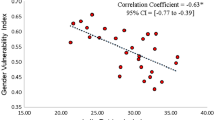Abstract
A demographic survey of eight Toposa villages in Southern Sudan was undertaken to delineate patterns of infant and childhood mortality. Among these predominantly egalitarian agro-pastoralists few standard socio-economic variables useful in the detection of demographic differentials were found. Instead, polygyny was used as a measure of social differentiation, hypothesizing that social differentiation induces demographic differences between polygynous and monogamous marriages. Analysis indicated social differentiation through gerontocracy, while significant differences in mortality and fertility levels were found berween monogamous and polygynous marriages, with the latter featuring higher fertility and mortality levels. Underlying rationale for these differences were sought through consideration of social and biological factors.
Similar content being viewed by others
References
BeanL. and G.Mineau: 1986, ‘The polygyny-fertility hypothesis: a re-evaluation’, Popul. Stud. 40, pp. 67–82.
BrassW. and A.Coale: 1968, ‘Methods of analysis and estimation’, in: W.Brass et al., (eds.) The Demography of Tropical Africa (Princeton University Press, Princeton), pp. 12–87.
CaldwellJ. and P.Caldwell: 1984, ‘The demographic evidence for the incidence and cause of abnormally low fertility in Tropical Africa’, W.H.O. Stats. Quart. 36, pp. 2–34.
Chowdhury, A.: 1981, ‘Infant deaths, determinants and dilemnas’, ICDDR, B Scientific Report 46, Dacca.
ColsonE.: 1958, Marriage and the Family Among the Plateau Tonga (Manchester University Press, Manchester).
CoaleA. and P.Demeny: 1968, Regional Model Life Tables and Stable Populations (Princeton University Press, Princeton).
CoaleA., A.Hill and T.Trussell: 1975, ‘A new method of estimating standard fertility measure from incomplete data’, Popul. Index 41, pp. 182–210.
CulwickA. and P.Culwick: 1939, ‘A study of population in Ulanga, Tranganyika Territory’, Sociology Review 31, pp. 25–43.
DorjahnV.: 1959, ‘Fertility, polygyny and their interrelations in Temne society. Amer. Anth. 60, pp. 838–860.
FrankO.: 1983, ‘Infertility in sub-Saharan Africa: estimates and implications’, Popul. and Dev. Rev. 9, pp. 137–144.
GulliverP. and P.Gulliiver: 1963, The Central Nilo-Hamites (International African Institute, London).
HajnalJ.: 1953, ‘Age at marriage and proportions marrying’, Popul. Stud. 7, pp. 111–136.
IsaacB.: 1980, ‘Female fertility and marital form among the Mende of rural Upper Bambara Chiefdom, Sierra Leone’, Ethnology 19, pp. 297–313.
IsaacB. and W.Feinberg: 1982, ‘Marital form and infant survival among the Mende of rural Upper Bambara Chiefdom, Sierra Leone’, Hum. Biol. 54, pp. 627–634.
KurupB. and E.Roth: 1985, Analysis of Toposa Demographic Data. (Report on file, United Nations Children's Fund, Khartoum).
OlusanyaP.: 1971, ‘The problem of multiple causation with particular reference to the polygyny-fertility hypothesis’, Soc. Rev. 19, pp. 165–172.
PageH. and R.Lesthaeghe: 1981, Child Spacing in Tropical Africa: Traditions and Change (Academic Press, London).
PhillipsA.: 1953, Survey of African Marriage and Family Life (Oxford University Press, London).
SembajweI.: 1979, ‘Effect of age at first marriage, number of wives, and type of marital union on fertility’, Biosoc. Sci. 11, pp. 341–351.
SchneiderG.: 1979, Livestock and Equality in East Africa: The Economic Basis of Social Structure (Indiana University Press, Bloomington).
SchwartzT.: 1978, ‘Fecondite et mortalite avant age de trois ans chez le Krou de Cote d'lvoire’, in: C.Oppong, (ed.), Marriage, Fertility and Parenthood in West Africa (Australian National Press, Canberra), pp. 67–73.
SchweitzerA.: 1941, Histoires de la Foret Vierge (Payot, Paris).
SmuckerC., G.Simmons, S.Bernstein and S.Misra: 1980, ‘Neonatal mortality in South Asia: the special role of tetanus’, Popul. Stud. 34, pp. 321–335.
SpencerP.: 1965, The Samburu: A Study of Gerontocracy in a Nomadic Tribe (University of California Press, Berkeley).
SpencerP.: 1980, Polygyny as social differentiation in African society, in: J.Mitchell, (ed.), Numerical Techniques in Social Anthropology (Institute for the Study of Human Issues, Philadelphia).
TrussellT.: 1975, ‘A re-examination of the multiplying factors for the Brass technique for determining childhood survivorship rates’, Popul. Stud. 29, pp. 97–108.
United Nations: 1983, Manual X: Indirect Techniques for Demographic Estimation (United Nations, New York).
Van DerWalleE.: 1968, ‘Marriage in African censuses and inquiries’, in: W.Brass et al., (eds.), Demography of Tropical Africa (Princeton University Press, Princeton), pp. 307–322.
WareH.: 1979, ‘Polygyny: women's views in a transitional society’, J. Marr. and Fam. 7, pp. 85–190.
Author information
Authors and Affiliations
Rights and permissions
About this article
Cite this article
Roth, E.A., Kurup, K.B. Polygyny as social and biological differentiation among Toposa agro-pastoralists of Southern Sudan. Soc Indic Res 22, 385–398 (1990). https://doi.org/10.1007/BF00303833
Received:
Issue Date:
DOI: https://doi.org/10.1007/BF00303833




